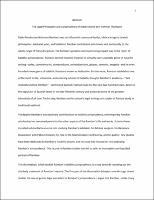Please use this identifier to cite or link to this item:
https://hdl.handle.net/20.500.12202/7910Full metadata record
| DC Field | Value | Language |
|---|---|---|
| dc.contributor.advisor | Kanarfogel, Ephraim | |
| dc.contributor.advisor | Berger, David | |
| dc.contributor.advisor | Halbertal, Moshe | |
| dc.contributor.author | Rosensweig, Itamar | |
| dc.date.accessioned | 2022-02-04T21:43:49Z | |
| dc.date.available | 2022-02-04T21:43:49Z | |
| dc.date.issued | 2022-01 | |
| dc.identifier.citation | Rosensweig, I. (2022, January). The Legal Philosophy and Jurisprudence of Rabbi Moshe ben Nahman (Ramban) (Publication No. 28966748) [Doctoral dissertation, Yeshiva University]. Proquest Dissertations & Theses Global. | en_US |
| dc.identifier.uri | https://hdl.handle.net/20.500.12202/7910 | |
| dc.identifier.uri | https://ezproxy.yu.edu/login?url=https://www.proquest.com/dissertations-theses/legal-philosophy-jurisprudence-rabbi-moshe-ben/docview/2635468836/se-2?accountid=15178 | |
| dc.description | Doctoral dissertation, PhD / Open Access | en_US |
| dc.description.abstract | Rabbi Moshe ben Nahman (Ramban) was an influential communal leader, biblical exegete, Jewish philosopher, kabbalist, poet, and halakhist. Ramban contributed extensively and profoundly to the whole range of these disciplines. Yet Ramban’s greatest and most lasting impact was in the realm of halakhic jurisprudence. Ramban penned halakhic treatises in virtually every available genre of halakhic writing--codes, commentaries, compendiums, animadversions, glosses, sermons, exegesis--and he even founded a new genre of halakhic literature known as hiddushim. Furthermore, Ramban established one of the most fertile, influential, and enduring schools of halakhic thought. Ramban’s academy—“beit midrasho shel ha-Ramban”—dominated Spanish Talmud study for the next two hundred years, down to the expulsion of Spanish Jewry in the late fifteenth century and produced some of the greatest talmudists of all time. To this day, Ramban and his school’s legal writings are staples of Talmud study in traditional yeshivot. ¶Yet despite Ramban’s extraordinary contributions to halakhic jurisprudence, contemporary Ramban scholarship has remained partial to the other aspects of the Ramban’s life and works. Scholars have invested substantial resources into studying Ramban’s kabbalah, his biblical exegesis, his Barcelona Disputation with Pablo Christiani, his role in the Maimonidean Controversy, and his poetry. Few studies have been dedicated to Ramban’s halakhic oeuvre, and no study has focused on characterizing Ramban’s jurisprudence. This lacuna in Ramban studies has left us with an incomplete and lopsided portrait of Ramban.¶This dissertation, which studies Ramban’s halakhic jurisprudence, is a step towards rounding out the scholarly treatment of Ramban’s oeuvre. The first part of the dissertation (chapters one through three) studies the role of geonic legal precedent in Ramban’s jurisprudence. I argue that Ramban, unlike many of his predecessors, placed enormous weight in geonic legal precedent, and I contend that one of Ramban’s central projects in his halakhic writings is to reestablish the importance of geonic precedent. I argue, against scholars who claim that Ramban was motivated by Andalusian patriotism, that Ramban’s position flows from three considerations: his conception of the Talmud as a “closed text”, his perception of the Geonim as possessing interpretative traditions from the Amoraim, and the need to maintain the stability and unity of the law. ¶The second part of the dissertation (chapters four through five) characterizes Ramban’s method of halakhic analysis. I argue, against the widely accepted scholarly view, that Ramban was not engaged in a form of tosafist dialectic. I contend, rather, that what is distinctive of Ramban’s method of talmudic analysis is best characterized as conceptualism. I offer several examples that illustrate Ramban’s conceptualism and contrast Ramban’s method with that of the tosafists. The third part of the dissertation (chapter six) studies the role of the biblical verse in Ramban’s normative halakhic jurisprudence. While the Babylonian Talmud is the unrivaled source of normative halakhah, contemporary scholars debate whether medieval halakhists also utilized their interpretation of the biblical verse to determine and decide normative Jewish law. I argue that the biblical verse was an important source for Ramban’s jurisprudence. On many occasions, Ramban appeals directly to his interpretation of the verse to derive normative halakhic conclusions | en_US |
| dc.language.iso | en_US | en_US |
| dc.relation.ispartofseries | ProQuest Dissertations and Theses Global;28966748 | |
| dc.rights | Attribution-NonCommercial-NoDerivs 3.0 United States | * |
| dc.rights.uri | http://creativecommons.org/licenses/by-nc-nd/3.0/us/ | * |
| dc.subject | Judaica studies | en_US |
| dc.subject | Law | en_US |
| dc.subject | History | en_US |
| dc.subject | Moshe ben Nahman | en_US |
| dc.subject | Nachmanides | en_US |
| dc.subject | Nahmanides | en_US |
| dc.subject | Ramban | en_US |
| dc.title | The Legal Philosophy and Jurisprudence of Rabbi Moshe ben Nahman (Ramban) | en_US |
| dc.type | Dissertation | en_US |
| Appears in Collections: | Bernard Revel Graduate School of Jewish Studies: Doctoral Dissertations | |
Files in This Item:
| File | Description | Size | Format | |
|---|---|---|---|---|
| Rosensweig The Jurisprudence of Ramban 2022Jan OA.pdf | 1.9 MB | Adobe PDF |  View/Open |
This item is licensed under a Creative Commons License

